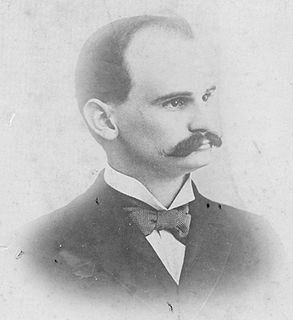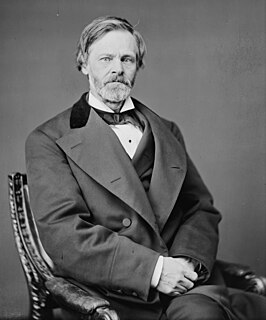
The Solid South or Southern bloc was the electoral voting bloc of the states of the Southern United States for issues that were regarded as particularly important to the interests of Democrats in those states. The Southern bloc existed especially between the end of Reconstruction in 1877 and the passage of the Civil Rights Act in 1964. During this period, the Democratic Party controlled state legislatures; most local and state officeholders in the South were Democrats, as were federal politicians elected from these states. During the late 1800s and early 1900s, Southern Democrats disenfranchised blacks in all Southern states, along with a few non-Southern states doing the same as well. This resulted essentially in a one-party system, in which a candidate's victory in Democratic primary elections was tantamount to election to the office itself. White primaries were another means that the Democrats used to consolidate their political power, excluding blacks from voting in primaries.
Southern Democrats, historically also known colloquially as Dixiecrats, are members of the U.S. Democratic Party who reside in the Southern United States.

Elections in Georgia are held to fill various state and federal seats. Georgia regular elections are held every even year. The positions being decided each year varies, as the terms of office varies. The State Senate, State House and U.S. House will typically be up for election, as all of those positions have two-year terms. Special elections are held to fill vacated offices. Georgia is one of seven states that require a run-off election if no candidate receives a majority of the vote in a primary election. Uniquely, Georgia requires a run-off election for state and congressional offices if no candidate wins a majority of the vote in a general election; only Louisiana has a similar requirement, but it operates under a different election system.

The 1984 United States Senate elections coincided with the landslide re-election of President Ronald Reagan in the presidential election. In spite of the lopsided presidential race, Reagan's Republican Party suffered a net loss of two Senate seats to the Democrats, although it retained control of the Senate and gained seats in the House.

The 1968 United States Senate elections were elections for the United States Senate which coincided with the presidential election of the same year. Although Richard Nixon won the presidential election narrowly, the Republicans picked up five net seats in the Senate. Republicans would gain another seat after the election when Alaska Republican Ted Stevens was appointed to replace Democrat Bob Bartlett.

The 1966 United States Senate elections were elections on November 8, 1966 for the United States Senate which occurred midway through the second term of President Lyndon B. Johnson. With divisions in the Democratic base over the Vietnam War, and with the traditional mid-term advantage of the party not holding the presidency, the Republicans took three Democratic seats. Despite Republican gains, the balance remained overwhelmingly in favor of the Democrats, who retained a 64–36 majority. These were also the first elections held after enactment of the Voting Rights Act of 1965.

The 1956 United States Senate elections were elections for the United States Senate that coincided with the re-election of President Dwight D. Eisenhower. Although Democrats gained two seats in regular elections, the Republicans gained two seats in special elections, leaving the party balance of the chamber unchanged.

The 1954 United States Senate elections was a midterm election in the first term of Dwight D. Eisenhower's presidency. Eisenhower's Republican party lost a net of two seats to the Democratic opposition. This small change was just enough to give Democrats control of the chamber with the support of an Independent who caucused with them.

In the 1912 and 1913 United States Senate elections, Democrats gained control of the Senate from the Republicans. Of the 32 seats up for election, 17 were won by Democrats, thereby gaining 4 seats from the Republicans. Two seats were unfilled by state legislators who failed to elect a new senator on time. They were the last Senate elections held before ratification of the 17th Amendment, which established direct elections for all seats in the Senate.

The 1896 South Carolina gubernatorial election was held on November 3, 1896 to select the governor of the state of South Carolina. William Haselden Ellerbe won the Democratic primary and easily won the general election to become the 86th governor of South Carolina.

The North Carolina Republican Party (NCGOP) is the affiliate of the Republican Party in North Carolina. Michael Whatley has been the chair since 2019.

The 1954 South Carolina United States Senate election was held on November 2, 1954 to select the next U.S. senator from the state of South Carolina. Senator Burnet R. Maybank did not face a primary challenge in the summer and was therefore renominated as the Democratic Party's nominee for the election in the fall. However, his death on September 1 left the Democratic Party without a nominee and the executive committee decided to nominate state Senator Edgar A. Brown as their candidate for the election. Many South Carolinians were outraged by the party's decision to forgo a primary election and former Governor Strom Thurmond entered the race as a write-in candidate. He easily won the election and became the first U.S. senator to be elected by a write-in vote in an election where other candidates had ballot access. A Senate election where the victor won by a write-in campaign would not happen again until 2010.

The 1944 South Carolina United States Senate election was held on November 7, 1944 to select the U.S. Senator from the state of South Carolina.

The 1914 United States Senate election in South Carolina was held on November 3, 1914 to select the U.S. Senator from the state of South Carolina. It was the first election in South Carolina in which the voters were able to choose the candidate in the general election. Incumbent Democratic Senator Ellison D. Smith won the Democratic primary and defeated nominal opposition in the general election to win another six-year term.

The 1913 South Carolina United States Senate election was held on January 28, 1913, when the South Carolina legislature met and unanimously ratified the results of the August 27, 1912 primary. Incumbent Senator Ben Tillman was re-elected to a fourth term in office.

The 1898 South Carolina United States Senate special election was January 26, 1898 election to pick the U.S. Senator from the state of South Carolina. The Democratic Party primary election was held on August 31, 1897. Prior to the ratification of the 17th Amendment to the United States Constitution, U.S. Senators were elected by the state legislature and not through the direct election by the people of the state. However, the Democratic Party of South Carolina organized primary elections for the U.S. Senate beginning in 1896 and the General Assembly would confirm the choice of the Democratic voters. Tillmanite Democrat John L. McLaurin won the Democratic primary and was elected by the General Assembly to serve the remainder of the six-year term expiring in 1903.

The 1903 South Carolina United States Senate election, held January 27, 1903 to select the U.S. senator from the state of South Carolina, was predetermined by the Democratic Party primary election held on August 26, 1902, and September 9. Democrats were so overwhelmingly dominant that their nomination was tantamount to the general election.

The 1909 South Carolina United States Senate election was held on January 26, 1909. Its outcome was determined by a Democratic Party primary election held on August 25 and September 8, 1908. Interim Senator Frank B. Gary, who had been elected to complete the unfinished term of the late Senator Asbury Latimer, did not run for re-election. Democrat Ellison D. Smith won the Democratic primary and was elected by the General Assembly for a six-year term.

The 1896 and 1897 United States Senate elections were elections in which the Democratic Party lost seven seats in the United States Senate, mostly to smaller third parties.

The 1920 United States presidential election in Arkansas took place on November 2, 1920, as part of the 1920 United States presidential election in which all 48 states participated. State voters chose nine electors to represent them in the Electoral College via a popular vote pitting Democratic nominee James M. Cox and his running mate, Assistant Secretary of the Navy Franklin Roosevelt, against Republican challenger U.S. Senator Warren G. Harding and his running mate, Governor Calvin Coolidge.


















